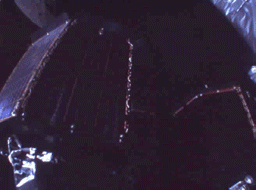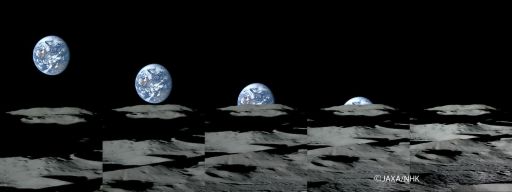Emily Lakdawalla • Sep 30, 2008
Doug Ellison at Europlanet 2008: Kaguya update
All last week, Doug Ellison filed reports from the third European Planetary Science Congress, also known as Europlanet, taking place in Münster, Germany. Doug is the dictator-for-life of the online forum unmannedspaceflight.com. Thanks, Doug! --ESL
On Friday Professor Manabu Kato, science manager for Kaguya gave an update on the mission (which it seems they still refer to as "Selene," given the layout of his Powerpoint slides). Most of you will have heard of and about Kaguya previously -- but a health report is certainly overdue!

JAXA
Kaguya deploys its mini-satellites
Views from a small onboard camera show the successful deployment of the lunar orbiter Kaguya's two mini-satellites. Each mini-satellite is an octagonal prism one meter in diameter with solar cells covering its 0.65-meter-long sides; the satellites will be used in a radio interferometry experiment to map the Moon's gravity. The first satellite, Okina (also known as the Relay satellite or Rstar), was released on October 9, 2007 into an elliptical orbit 100 by 2,400 kilomters in size (first two frames). The second satellite, Ouna (also known as the VRAD satellite or Vstar), was released on October 12, 2007 into an elliptical orbit 100 by 800 kilometers in size (last two frames). Okina and Ouna, meaning "honorable elderly man" and "honorable elderly woman," refer to the old couple who adopted the moon princess Kaguya in the Tale of the Bamboo Cutter.Kaguya is probably most well known for carrying HDTV technology to the moon to record high definition video of flying over the lunar surface, and image Earth setting and rising over the limb of the Moon. To date, 60 minutes of HDTV footage has been downlinked. All the instruments except two are functioning well, the unspecified trouble being with the X-ray Spectrometer and Charged Particle Spectrometer.
Kato showed a global Gamma Ray spectra that showed very strong spikes in uranium, aluminium, potassium, silicon, thorium, oxygen, titanium, and iron (see this abstract for more details ). They have had interruptions on GRS use, so to date have about three months of good analysis, and will build better-resolution maps of elemental distribution as time allows.

JAXA / NHK
Kaguya Earthset sequence
Kaguya captured the blue marble of Earth setting below the Moon's north pole on November 7, 2007. This image is a still from a high-definition movie shot with Kaguya's telephoto HD camera. The Australian continent can be seen at the left center of Earth, and Asia to the lower right; because the view is across the Moon's south pole, Earth appears "upside down". The five frames were taken about 20 seconds apart.Their laser altimeter elevation data is at a coarser resolution, but they now have global coverage. This was demonstrated with both a single profile across a 2.5-kilometer-deep crater, and a stunningly sharp global elevation map. In a way similar to the radar sounding of Mars conducted by SHARAD on Mars Reconnaissance Orbiter and MARSIS on Mars Express, Kaguya is getting radar profiles of the lunar surface. This was actually done previously by the Apollo command and service modules, but only in a few small equatorial regions and at a relatively low resolution of three kilometers per pixel. Kaguya is getting profiles at 500 meters per pixel, and they are trying to calibrate to better understand the signals they are getting.
Kaguya deployed two sub-satellites while maneuvering into its final orbit, and by using Kaguya, the sub-satellites and the ground station as a four-way radio network, high-resolution gravity field maps have been produced of the near side and, uniquely, the far side. The gravity map showed some localized gravitational highs on the near side, but the far side is noisier, with highs at large crater rims. Apollo crater is a local gravity low, whereas Mare Serenitatis is a high gravity anomaly. The first of the sub-satellites will impact the moon next February, on the lunar far side. It is because of the slightly lumpy nature of the very gravity field it's designed to map that its orbit will decay.
Kaguya is clearly getting very, very good science, and as the first spacecraft of the International Lunar Decade, it's setting a high bar for the missions that have already followed, and are yet to join in. There is not a great deal of finished science to be drawn from
Support our core enterprises
Your support powers our mission to explore worlds, find life, and defend Earth. You make all the difference when you make a gift. Give today!
Donate

 Explore Worlds
Explore Worlds Find Life
Find Life Defend Earth
Defend Earth

